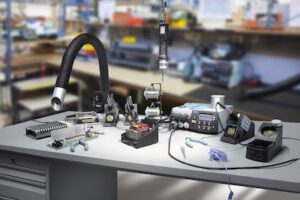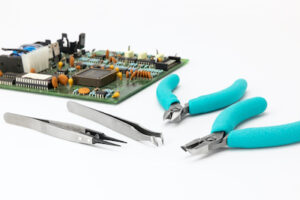By Marcel Teller, Global Product Manager, Weller
During this uncertain time, we are all experiencing the changes related to the new reality created by COVID-19. It is difficult to know how to defend ourselves and how to resume our daily lives, especially with all the new precautions: social distancing, use
of masks and frequent sanitation. For months, we have been locked in our houses with minimum social contact. Even professionally speaking, most of us have been forced to stay out of our offices while trying to conduct some kind of business. Despite these challenges, Weller has continued to distribute its products and has been in constant contact (via telephone and Web) with its distribution network and end-users. In the first lockdown phase, all the main companies used the Web for online presentations and training – a process that has proven to be both useful and interesting and that probably many will consider using even once we “return to normal.” It is beneficial to discuss a problem or an opportunity quickly, gathering information and then preparing the next phase (testing the proposed solution, organizing a meeting, etc.). Even hosting an online site visit can make a company’s service faster, less invasive and more effective. As we continue moving into new phases and some of us return to our offices (and for those of us who never left their offices because of their essential status), companies’ first concern remains that of making the facility, the operators and the equipment safe and compliant, as well as dealing with the collapse of orders.
 To avoid cross-contamination and possible contagions, it is important to constantly clean surfaces, equipment and tools: most units (including displays), styles and accessories have no problems with sterilization. However, there are so many sanitizers that it is impossible to guarantee that effectiveness levels are the same for every operator. Consequently, the best solution is to give each operator a personal tool (or set of tools), which s/he alone uses, in combination with the control units that are common to all. Weller has been recommending this practice for years in all cases where instrumentation is shared (especially in the case of companies that work on multiple shifts). In this way, cross-contamination is avoided, and it becomes easier to verify the effective duration of consumable parts, possibly even identifying which are the most critical and, consequently, taking the necessary precautions. Also, operators feel more motivated when entrusted with the care and maintenance of their personal instruments, generally extending the instruments’ lifespan. An ancient Venetian saying, “el can de tanti paroni el more de fame,” translates to “the dog of many owners dies of hunger.” In this context, it means that shared things often are not treated as well. Additionally, because of the extreme flexibility of the Weller soldering units, different types of tools and tips can be connected to a single unit (approximately 1000 tip/soldering iron combinations for each control unit) according to users’ personal preferences. This can help improve efficiency and accuracy. The WX tool technology also has memory integrated into the handle that records operating parameters, keeping all settings independent of the unit to which an operator connects.
To avoid cross-contamination and possible contagions, it is important to constantly clean surfaces, equipment and tools: most units (including displays), styles and accessories have no problems with sterilization. However, there are so many sanitizers that it is impossible to guarantee that effectiveness levels are the same for every operator. Consequently, the best solution is to give each operator a personal tool (or set of tools), which s/he alone uses, in combination with the control units that are common to all. Weller has been recommending this practice for years in all cases where instrumentation is shared (especially in the case of companies that work on multiple shifts). In this way, cross-contamination is avoided, and it becomes easier to verify the effective duration of consumable parts, possibly even identifying which are the most critical and, consequently, taking the necessary precautions. Also, operators feel more motivated when entrusted with the care and maintenance of their personal instruments, generally extending the instruments’ lifespan. An ancient Venetian saying, “el can de tanti paroni el more de fame,” translates to “the dog of many owners dies of hunger.” In this context, it means that shared things often are not treated as well. Additionally, because of the extreme flexibility of the Weller soldering units, different types of tools and tips can be connected to a single unit (approximately 1000 tip/soldering iron combinations for each control unit) according to users’ personal preferences. This can help improve efficiency and accuracy. The WX tool technology also has memory integrated into the handle that records operating parameters, keeping all settings independent of the unit to which an operator connects.
 The same is true for soldering accessories such as wire cutters, pliers and precision tweezers. Because these tools often are shared, it is essential to equip each operator with their own set to avoid cross-contamination and, if desired, each can have a type of tool more suited to individual needs and preferences. This will result in an increased life expectancy of these accessories while increasing each operator’s efficiency and overall output.
The same is true for soldering accessories such as wire cutters, pliers and precision tweezers. Because these tools often are shared, it is essential to equip each operator with their own set to avoid cross-contamination and, if desired, each can have a type of tool more suited to individual needs and preferences. This will result in an increased life expectancy of these accessories while increasing each operator’s efficiency and overall output.
Another important issue, especially in the times of COVID-19, is clean air. During these pandemic circumstances, ensuring a healthy working environment is not only necessary, it is mandatory. Weller’s fume extraction and filtering systems are created to make air in the work area healthier by removing contaminated fumes generated in the welding and rework processes as well as those complementary to them (gluing, MEK, VOC, etc.). The systems eliminate harmful substances (dust and gas) from the areas covered by the suction arms (tubes or hoods). Although 100% efficiency against nano-molecular viruses such as COVID-19 (0.12 µm) cannot be guaranteed due to the HEPA H13 filters that many Weller fume extraction systems are equipped with (efficiency > 99.955% in MPPS for particles of 0.16 µm and > 99.994% for particles of 0.3 µm), the presence of these molecules in the air are extremely contained. Ensuring greater air purity in the operators’ work area improves comfort levels and removes the risk of lung irritation or allergic reactions caused by the fumes, which can weaken the body and immune system, making them more sensitive to infection as well as to known pathogens. As always, but even more so today, it is important to take the necessary precautions during the filter replacement and disposal process.
Social distancing is another challenge: companies must keep operators away from each other while ensuring productivity. The Weller WTBR1000 bench welding robot solves that problem. A cubic meter of German technology, the robot only requires a support table. It does not need a more complex and expensive production line. It guarantees productivity but, above all, it increases result repeatability, excluding quality fluctuations or collapses of outgoing products caused by anti-COVID-19 contingencies. Simple to install and use, the robot features a double drawer system with automatic opening/closing, and the feeder sensors, pressure sensors and safety barriers manage the safety of the operator, the unit and the process. The three-level login software guarantees distinct privileges depending on who enters the unit software: operators can only start and stop the program while administrators can change the work program and other more detailed settings, and service teams have access to the machine commands. The operators, who load and unload the drawers, do not need any technical knowledge or experience with automation or CNC machines; the management is very simple, safe and error-proof. The technicians, who create the work programs (the actual process), do not need to be a programmer or even have that background since the software is very intuitive. With a few hours of training (a training day is included with the purchase of the Weller robot), users are ready and self-sufficient. Additionally, the robot is accessible remotely for technical support or for periodic verification.
While the COVID-19 pandemic is challenging the world, Weller understands that business needs to keep moving forward. The company’s technologies and solutions are both innovative and creative enough to produce positive results while helping companies meet safety requirements and keeping employees safe.
For more information, contact Weller at marketing@weller-tools.com or visit www.weller-tools.com.

